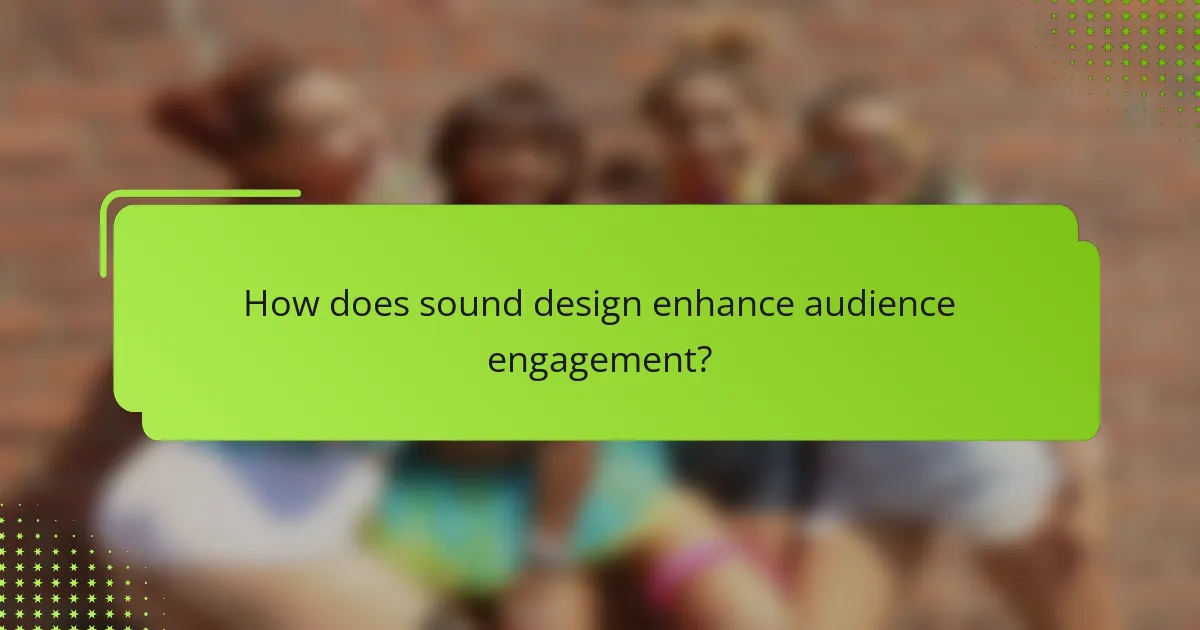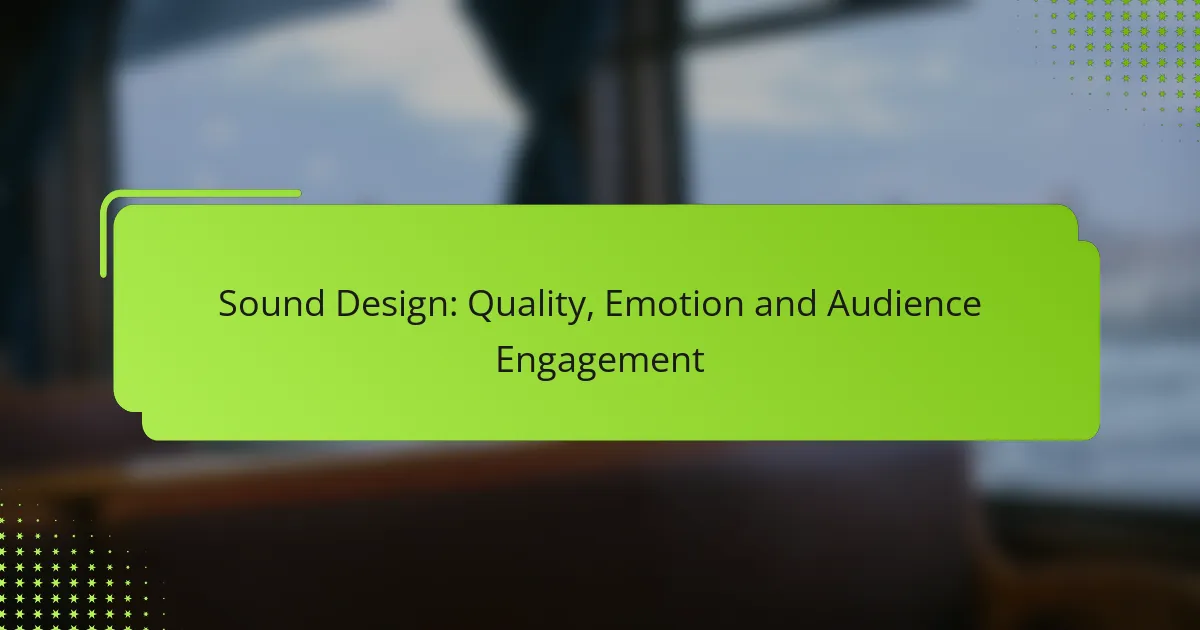Sound design is a vital component of storytelling that enhances audience engagement by crafting an emotional atmosphere and reinforcing the narrative. Through the careful selection and manipulation of audio elements, creators can immerse viewers or players in a more memorable experience, while quality sound design ensures clarity, balance, and dynamic range, resonating deeply with the audience’s emotions.

How does sound design enhance audience engagement?
Sound design significantly enhances audience engagement by creating an emotional atmosphere and reinforcing the narrative. By carefully selecting and manipulating audio elements, creators can draw viewers or players deeper into the experience, making it more memorable and impactful.
Emotional connection through sound
Sound design fosters emotional connections by using music, sound effects, and silence to evoke specific feelings. For instance, a suspenseful score can heighten tension, while a soft melody may evoke nostalgia or comfort. This emotional resonance keeps audiences invested in the story or experience.
To effectively create emotional connections, consider the context of the scene and the intended audience response. Using familiar sounds or culturally relevant music can enhance relatability, making the experience more engaging.
Improved storytelling with audio
Audio elements play a crucial role in storytelling by providing context and depth to the narrative. Dialogue, sound effects, and background music can convey information that visuals alone may not express. For example, the sound of a clock ticking can build anticipation or signify the passage of time.
When integrating audio into storytelling, ensure that it complements the visuals rather than distracts from them. A well-timed sound effect can enhance a pivotal moment, while excessive or poorly placed audio can detract from the overall impact.
Immersive experiences in film and gaming
In film and gaming, sound design creates immersive experiences that transport audiences into the narrative world. Surround sound technology and spatial audio techniques allow users to feel as if they are part of the action, enhancing realism and engagement. For instance, in a horror game, directional sound can make players feel vulnerable as they hear footsteps approaching from behind.
To maximize immersion, consider the use of ambient sounds that reflect the environment. Layering different audio elements can create a rich soundscape that draws audiences in and keeps them engaged throughout the experience.

What are the key elements of quality sound design?
Quality sound design hinges on clarity, balance, dynamic range, and spatial awareness. These elements work together to create an immersive audio experience that resonates emotionally with the audience.
Clarity and balance in audio
Clarity in audio ensures that each sound element is distinct and understandable, while balance refers to the appropriate levels of different audio components. Achieving clarity involves careful equalization to prevent frequencies from clashing, which can muddy the overall sound.
To maintain balance, consider using reference tracks that exemplify good mixing practices. Regularly adjusting levels during the mixing process can help achieve a harmonious blend, ensuring no single element overpowers the others.
Use of dynamic range
Dynamic range refers to the difference between the quietest and loudest parts of an audio piece. A well-managed dynamic range enhances emotional impact, allowing soft moments to breathe while delivering powerful crescendos effectively.
When designing sound, aim for a dynamic range that suits the genre and context. For instance, film scores often utilize a wide dynamic range to evoke strong emotions, while pop music might favor a more compressed range for consistent loudness across playback systems.
Spatial awareness in sound placement
Spatial awareness in sound placement involves positioning audio elements within a three-dimensional space, creating a sense of depth and immersion. This can be achieved through panning, reverb, and stereo imaging techniques.
To enhance spatial awareness, consider the listener’s perspective. Use stereo panning to place sounds on the left or right, and apply reverb to simulate distance. This approach helps the audience feel as though they are part of the environment, increasing engagement with the content.

How can sound design influence emotions?
Sound design plays a crucial role in shaping emotions by using various auditory elements to evoke specific feelings in the audience. By carefully selecting music, sound effects, and frequencies, creators can enhance the emotional impact of their work, leading to a more engaging experience.
Music and mood correlation
Music has a profound effect on mood, often dictating the emotional tone of a scene. For instance, a slow, melancholic melody can evoke sadness, while an upbeat tempo can inspire joy and excitement. Understanding the correlation between music and mood allows sound designers to select tracks that align with the desired emotional response.
When choosing music, consider the genre and instrumentation, as these factors can significantly influence perception. For example, orchestral music often conveys grandeur or drama, while electronic music may evoke a sense of modernity or urgency.
Sound effects and psychological impact
Sound effects can create a visceral psychological impact, enhancing the realism of a scene and influencing audience emotions. For example, the sound of a door creaking can instill tension and fear, while the sound of laughter can promote feelings of happiness and comfort. Effective use of sound effects can immerse the audience in the narrative.
To maximize the psychological impact, sound designers should consider the context in which sound effects are used. Subtle sounds can enhance realism, while exaggerated effects can heighten drama. Always test sound effects with the intended audience to gauge their emotional responses.
Frequency and emotional response
Different frequencies can elicit distinct emotional responses, making frequency selection a vital aspect of sound design. Low frequencies, such as bass, often evoke feelings of power or fear, while higher frequencies can create a sense of happiness or alertness. Understanding these relationships helps sound designers craft experiences that resonate emotionally.
When designing soundscapes, consider using a range of frequencies to create a balanced emotional palette. For example, combining low, mid, and high frequencies can create depth and complexity, enhancing the overall emotional experience. Avoid overwhelming the audience with extreme frequencies, as this can lead to discomfort or distraction.

What tools are essential for sound design?
Essential tools for sound design include Digital Audio Workstations (DAWs), audio plugins and effects, and field recording equipment. These tools enable sound designers to create, manipulate, and capture audio effectively, enhancing the overall quality and emotional impact of their projects.
Digital Audio Workstations (DAWs)
A Digital Audio Workstation (DAW) is software used for recording, editing, and producing audio files. Popular DAWs like Ableton Live, Pro Tools, and Logic Pro offer a range of features, including multi-track recording, MIDI support, and built-in effects. When choosing a DAW, consider your workflow preferences and the specific requirements of your projects.
Many DAWs provide trial versions, allowing you to test their capabilities before committing. Look for features such as user-friendly interfaces, compatibility with your operating system, and support for third-party plugins to ensure a smooth sound design experience.
Audio plugins and effects
Audio plugins and effects enhance the capabilities of your DAW by adding new sounds and processing options. Common types include equalizers, compressors, reverb, and virtual instruments. When selecting plugins, consider their compatibility with your DAW and the specific sound design needs of your project.
Many audio plugins are available as free or paid options, with popular choices like Waves, FabFilter, and Native Instruments. Experimenting with different plugins can help you find the right tools to achieve your desired sound, but be cautious not to overload your sessions with too many effects, which can lead to performance issues.
Field recording equipment
Field recording equipment is essential for capturing high-quality sound in various environments. Key items include portable recorders, microphones, and windshields. Popular portable recorders like the Zoom H5 or Tascam DR-40X offer good audio quality and battery life, making them ideal for on-location recordings.
When selecting microphones, consider the type of sound you want to capture. Dynamic microphones are great for loud sources, while condenser microphones excel in capturing subtle details. Always test your equipment in the intended environment to ensure optimal results, and be mindful of local regulations regarding recording in public spaces.

How to choose the right sound design for a project?
Selecting the appropriate sound design for a project involves understanding the emotional tone and audience engagement you wish to achieve. Consider the project’s goals, the target demographic, and how sound can enhance the overall experience.
Understanding the target audience
Identifying your target audience is crucial for effective sound design. Different demographics respond uniquely to various sound elements, such as music genres, sound effects, and voiceovers. For instance, younger audiences may prefer upbeat and contemporary sounds, while older demographics might resonate more with classic or nostalgic audio.
Conducting audience research can provide insights into preferences and expectations. Surveys, focus groups, or analyzing similar projects can help determine what sound elements will engage your audience effectively.
Aligning sound with brand identity
Sound design should reflect and reinforce your brand identity. This includes using specific tones, styles, and audio motifs that are consistent with your brand’s message and values. For example, a luxury brand might opt for elegant and sophisticated soundscapes, while a tech startup might choose modern and innovative audio cues.
Ensure that the sound elements are coherent across all platforms, from advertisements to social media. Consistency in sound helps in building brand recognition and can enhance emotional connections with the audience.



